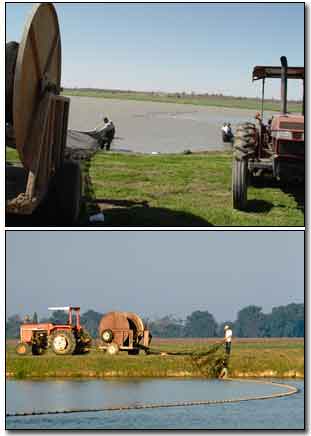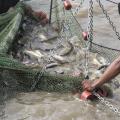Harvesting Catfish
Efficient harvesting of channel catfish ponds is important to all phases of channel catfish culture. The techniques currently employed by the industry evolved primarily from Great Lakes haul seine techniques. There has been very little systematic research conducted to improve on existing techniques. Most of the innovations implemented in harvesting fish during the past twenty years have been the result of trial-and-error by fish producers and custom seining crews.
 Preparation. Successful harvesting operations require properly constructed ponds. Levees should be wide enough to accommodate large hauling trucks, tractors, and fish loading equipment. Gravel is imperative on main levees where fish will be loaded onto hauling trucks. All other levees should have a good ground cover (or preferably gravel) to permit seining in all types of weather.
Preparation. Successful harvesting operations require properly constructed ponds. Levees should be wide enough to accommodate large hauling trucks, tractors, and fish loading equipment. Gravel is imperative on main levees where fish will be loaded onto hauling trucks. All other levees should have a good ground cover (or preferably gravel) to permit seining in all types of weather.
To ensure the most efficient harvest possible for any given pond, producers must be certain that the production pond contains an adequate amount of fish of harvestable size. To minimize the expense per pound of fish transported to the processing plant, the transport truck needs to be filled to or near capacity. Typically, a producer marketing fish to a large processor will not schedule a harvest until 20,000 to 25,000 pounds of graded fish will be retained in the harvest net.
Prior to each food fish harvest, producers must arrange for their fish to be placed on the processing schedule. Producers must first submit fish samples to processing plants to check flavor quality. Once a processor determines that a pond is “on-flavor”, the process of scheduling the harvest can begin. There are many factors that complicate scheduling including, processing rights, proximity to plants, availability of fish, and re-occurrence of off-flavor.
Basic equipment. The basic requirements are similar for fingerling and food fish harvesting operations. Equipment requirements consist of a commercial harvest seine, a hydraulic seine reel, a flat-bottomed aluminum boat outfitted with an outboard motor and a seine catcher, two tractors, and various live cars for holding and grading fish. An additional tractor equipped with a PTO-driven aerator is recommended to keep water moving in any area where fish are concentrated.
In order for a seine to operate properly, the length of the seine should be 1.5 times the widest section of the pond. This allows the seine bottom to conform to the shape of the pond bottom and minimizes the tension on the mud-line. In general, the depth of the seine should be 1.5 times the deepest section of the pond. Most food-fish seines are 9 foot deep for use in delta-style ponds, but may be as much as 12 foot deep for use in deeper watershed-style ponds. The vast majority of fingerling seines in use on commercial farms are 8 foot deep, but some deeper, watershed style ponds require 10 foot deep seines.
Basic harvesting operation. While the process of seining a pond is straight-forward, a certain amount of skill and an understanding of basic fish needs are required to land fish successfully with a minimum amount of stress. Even under ideal conditions, a typical seine haul will seldom catch more than two thirds of the fish in a levee style pond.
Typically, at least five persons are required to seine a commercial pond. Two persons are required to drive tractors; one to pull the hydraulic seine reel, and the other to pull the other end of the seine. Two more individuals are required to stand on the mudline at the base of the levee as the seine is pulled through the pond. The fifth individual is required to operate the seining boat and monitor the seine as it is pulled through the water, watching for indications that the seine is catching too much mud.
Once both ends of the seine are pulled around the corners of the pond, the tractors converge in the vicinity of where the hauling truck will eventually be loaded. This area should be clear of overhead power lines and the pond bottom and water depth should be suitable for containing the fish in a net enclosure, grading, and loading out. Often, producers choose to land fish close to the aerator and the well to help improve water quality in the area where fish will be confined.
Technical Advances. Researchers at Mississippi State University have developed a novel design for catfish seines. The original design for the seine was developed in collaboration with the National Marine Fisheries Service Lab in Pascagoula, Mississippi. The seine design incorporates braided polyethylene mesh, a modified mud roller, a larger seine tunnel, and replaces the frame mechanism used to mate the seine to the live car with an industrial-strength zipper system. The braided polyethylene mesh is a good choice for constructing seines and socks. The modified mud roller design eliminates much of the “mudding down” problems associated with older muddy ponds. The zipper system allows the sock to be attached quicker and eliminates the potential for twisting of the seine tunnel. More importantly, it eliminates the “bottleneck” effect of crowding fish through a tunnel and frame, which can significantly reduce the amount of time required to land fish in live cars. A prototype seine was used to harvest catfish from ponds ranging from 4 to 10 acres at the NWAC. Average catch was 20 percent better than with conventional seines and seining time was reduced by 45 percent.
Grading
Most intensive catfish production operations employ the sock grading method of landing and grading fish. Typically, a tunnel is sewn approximately 100 to 125 feet from the end of the harvest seine. An open-topped net enclosure known as a live car or sock is attached to the harvest seine tunnel. The harvest seine is carefully pulled toward the levee as fish pass through the tunnel and into the sock.
Grading catfish with socks depends on mesh size, time, water temperature, water quality, and the general health of the fish. Typically, to achieve the desired level of grading, fish must be held in socks for a minimum of four to six hours. It is common for producers to hold fish overnight in grading socks to encourage removal of small fish. Socks must be staked out properly in order to avoid fish escaping and to encourage grading. A tractor PTO-driven paddlewheel aerator should be placed along the bank to gently pull oxygenated water through the sock.
Technical Advances. An adjustable horizontal bar grader for sorting channel catfish has been developed by David Heikes at the University of Arkansas at Pine Bluff and has proven to be a valuable management tool for fingerling production on several commercial farms. A larger version of the in-pond grader design is currently under investigation and shows promise for grading foodfish. Grading foodfish with the in-pond grader involves additional handling and labor, but allows a producer to grade a crop of foodfish immediately after seining. The grader can grade 10,000 pounds of food-sized catfish in 2 to 6 minutes. One series of tests showed that 5 to 11 percent more weight of sub-harvestable size fish can be graded compared to current technology, resulting in a 12.5 percent increase in average weight of fish available for processing. Once the fish have been graded with an in-pond grader, inventory estimates can be obtained from the holding sock. The use on an in-pond grader may be particularly well suited to grading fish in cold weather when sock grading efficiency drops off.
Loading
Loading channel catfish from holding socks onto transport tanks is typically accomplished with a hydraulic loader outfitted with a boom, lift net, and hanging scale. Two of the most common types of hydraulic loaders are a modified backhoe and a reconditioned logging truck. A long boom is attached to the hydraulic arm of the loader to extend the basket to the live car from the pond bank and lift the fish up to the transport tank. The lift net is suspended from a hanging scale attached to the boom. The fish are weighed before being released into the tank through the trap door in the bottom of the lift net.
Transport
Channel catfish can withstand the rigors of transport fairly well at all life stages. However, proper procedures are critical during transport of eggs, fry, and fingerlings because damage or stress can result in poor survival. Care should also be taken when “live hauling” food-sized catfish to specialty markets because they are expected to remain alive for extended periods until sold to the final consumer. Food-sized catfish bound for processing plants are transported at higher densities because fish are held only briefly before slaughter.
MSU Publications & Information
- Research Yields New Equipment for Catfish Industry
MAFES Research Highlights: Spring 1997 - Search Extension Catfish/Aquaculture Publications
Other Catfish Harvesting Information
- Harvesting Warmwater Fish
SRAC Fact Sheet No. 394 - Sorting and Grading Warmwater Fish
SRAC Fact Sheet No. 391 - Transportation of Warmwater Fish: Equipment and Guidelines
SRAC Fact Sheet No. 390 - Transportation of Warmwater Fish: Procedures and Loading Rates
SRAC Fact Sheet No. 392 - Transportation of Warmwater Fish: Loading Rates and Tips by Species
SRAC Fact Sheet No. 393 - Additional Southern Regional Aquaculture Center Fact Sheets
Publications
News
STARKVILLE, Miss.
Coastal wetland conservation and restoration projects along the Mississippi Gulf Coast and beyond are running into a distinct challenge: there often aren’t enough locally sourced native plants readily available to complete these efforts.
The Mississippi State University Extension Service is meeting this problem head-on by enlisting plant enthusiasts to grow and sell these marsh plants. The effort is organized as the Native Plant Producer Network, or NPPN, and it was started in 2023.
STARKVILLE, Miss. -- Lower feed prices are providing some relief to Mississippi’s catfish producers, but many are still facing more than their share of obstacles just to break even.




